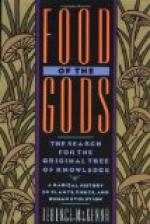[Illustration—Drawing: MAP OF GRENADA, BRITISH WEST INDIES.]
Next in importance to Trinidad is the little island of Grenada; here cacao is the staple industry, the sugar estates that once lined the shores having entirely disappeared. Grenada cacao is smaller than that of Trinidad, possibly on account of the different method of planting described in a previous chapter, but the flavour of the bean is exceedingly good and regular, and the crop is bought up eagerly on the British and American markets. The other West Indian islands producing cocoa are Jamaica and Dominica, where its cultivation is reviving; also St. Lucia, St. Vincent, Tobago, and Montserrat, each of which have a few plantations; those in St. Vincent suffered severely by the recent hurricane. The French islands of Guadeloupe and Martinique supply exclusively to the port of Havre; the cocoa from San Domingo is of a somewhat inferior quality. Cuba will probably considerably extend its output under American rule.
[Illustration—Black and White Plate: A Hill Cacao Estate, Grenada, B.W.I.]
[Illustration—Drawing: MAP OF PRINCIPE.]
In the Eastern Hemisphere by far the largest supplies come from the small islands of St. Thome and Principe, in the Gulf of Guinea, belonging to the Portuguese. These have in recent years proved especially adapted for the growth of the cacao, and the exports, especially from the island of St. Thome, are very large; most of the crop finds its way to European markets, transhipping at Lisbon. There is little cacao grown in the mainland African colonies, though the German Government offers special inducements in the Kameruns; no British African colony grows it to any extent. Fernando Po sends supplies to Spain, and occasionally on the London market strange packages made of rough cowhide stitched with leather thongs are seen, containing beans from Madagascar.
[Illustration—Drawing: MAP OF S. THOME.]
[Illustration—Black and White Plate: Ceylon: Carting Cacao to Rail.]
[Illustration—Drawing: MAP OF CEYLON.]
Further east are the plantations of Ceylon. In the hill districts, of which Matale is the centre, are many estates, some in joint cultivation of tea and cocoa. The output from this colony is at the present time nearly stationary. The Dutch East Indian produce is almost exclusively shipped to Amsterdam.
[Illustration—Drawing: MAP OF SAMOA.]
In the preceding pages extracts have frequently been culled from writers of the past: in the literature of the present day Charles Kingsley’s graphic account of Trinidad and its cacao and sugar plantations in “At Last” should be read in extenso. Another very interesting episode of modern date is the introduction of the cacao into the Samoan Islands in the Pacific by Robert Louis Stevenson. Writing to Sidney Colvin, on December 7, 1891, in one of his “Vailima Letters,” he says:




